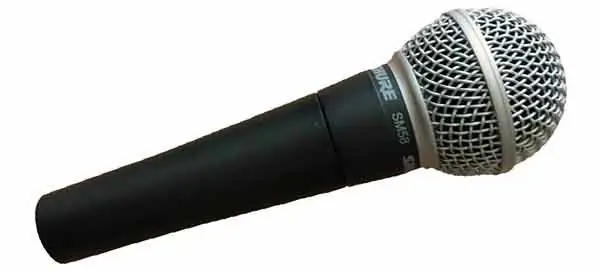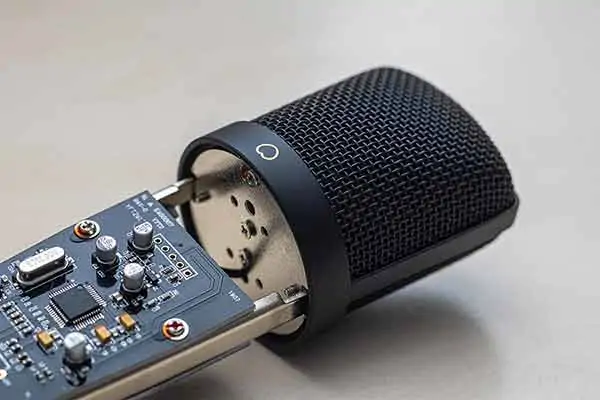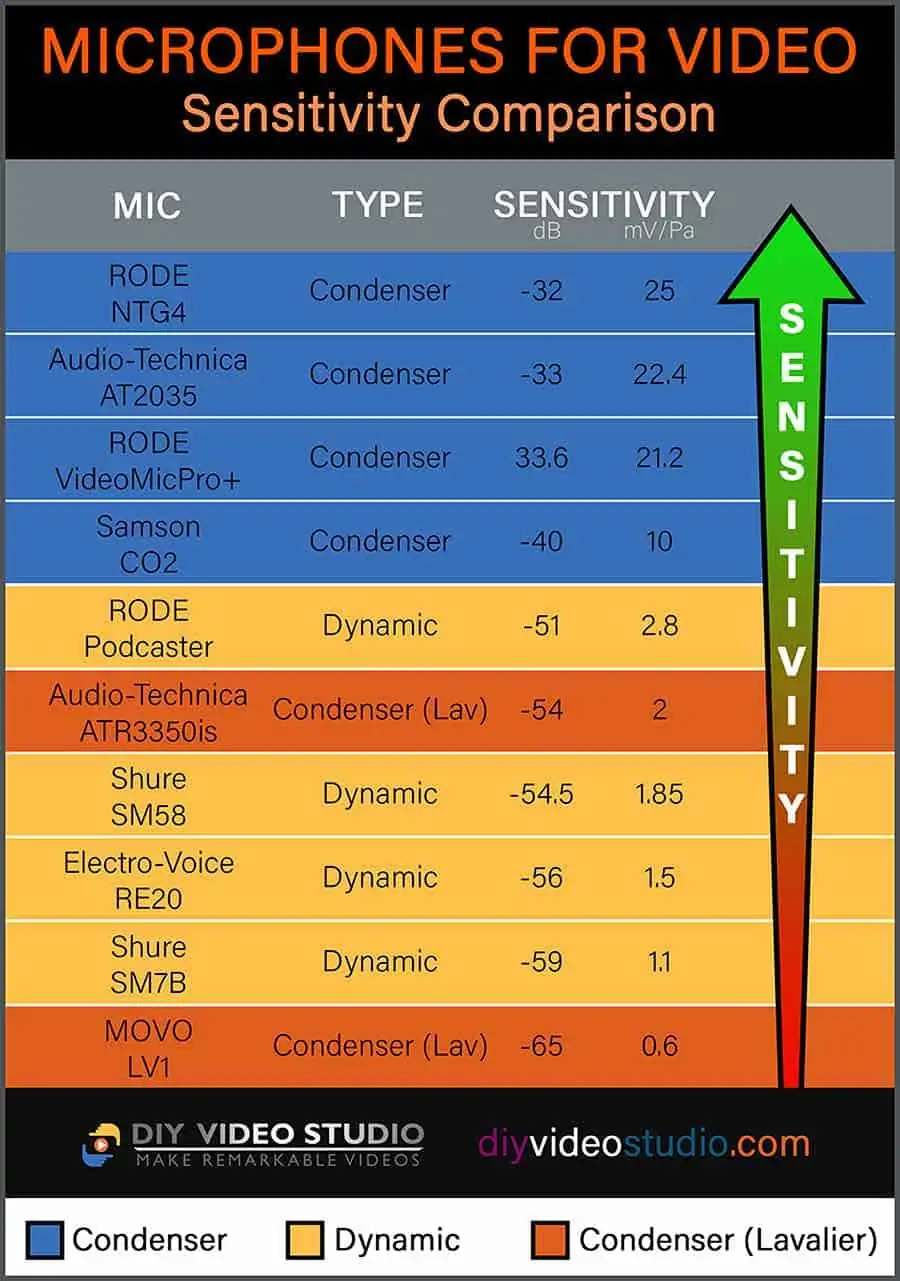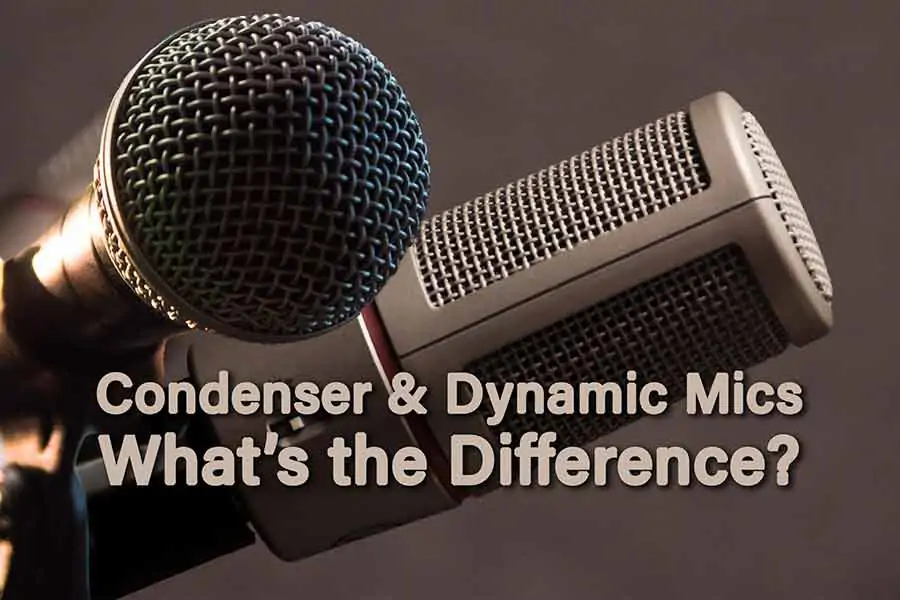DIY Video Studio is supported by its readers. Please assume links on this site are affiliate links or ads, and that I get commissions for purchases made through these links. As an Amazon Associate, I earn from qualifying purchases. Thank you if you use any of the links.
Although there are other types of microphones you can buy, the main ones for video production are condenser and dynamic mics. So, what is the difference between condenser and dynamic mics, and should you use one rather than the other?
Both condenser and dynamic mics are used for video production, whether it is for creating YouTube videos or TV news and program production. To know which type of microphone to use in specific situations we need to know more about how they work and their features.
Dynamic microphones
Last update on 2025-07-01 / Affiliate links / Images from Amazon Product Advertising API
What is a dynamic microphone?

The design of Dynamic microphones is simpler than that of condenser microphones, with relatively few internal parts. For this reason, they tend to be robust, reliable, and resist a lot of rough handling.
However, modern solid-state electronic components have enabled condenser microphone design to rival the robustness of dynamic mics. For instance, if a microphone is dropped onto a hard floor the high acceleration forces may damage the suspended coil in a dynamic mic.
Those same forces may not affect the solid-state electronic components so severely. None-the-less, dynamic microphones are generally regarded as being better able to withstand rough handling.
Dynamic microphones can handle high Sound Pressure Levels (SPL), or what people commonly think of as loudness. Dynamics will accept higher levels before they start to distort. They produce a consistent sound quality across a wide range of situations.
Dynamic mics do not require power
Since dynamic microphones do not normally have extra electronic components, they do not require any power, either from your recording equipment or from internal batteries. But this is not always the case. There are some powered dynamic mics, and they are usually referred to as active dynamic microphones
An example is the Blue enCORE 200 that uses phantom power. It is a vocal mic that the makers claim will give you studio-grade quality while performing onstage. So, it will take a degree of rough handling while also sounding great.
Dynamic mics are robust
Dynamic microphones are quite robust since there have few components that can fail. Therefore, dynamic mics are popular with touring bands and live musicians.
Normally rough handling involves the mic being dumped into a kit bag or swung around onstage by its cable, but Shure Microphones recorded a video to demonstrate how the Shure SM58, a dynamic mic, handles being thrown into the ocean, crushed by a pick-up truck, and barbecued. Apart from some superficial damage, the SM58 survived and continued to perform well as a microphone.
How dynamic microphones work
Dynamic microphones use an electro-mechanical method to convert sound energy into electrical energy. The microphone capsule consists of a diaphragm linked to a coil of wire that is suspended within a magnetic field. Incoming sound waves cause the diaphragm and coil to vibrate. When a wire moves within a magnetic field a current is induced or generated.
However, the induced current is small, so the wire is wound into a coil, effectively magnifying the induced current. Since the sound waves cause a back-and-fore vibration in the coil, the electrical current is also a vibration that is manifested at the microphone’s output as a varying voltage that we use in a camera or recorder.
In the case of the mic capsule, the coil of wire vibrates back and fore in the magnetic field, which generates a vibrating electrical current. It is this electrical vibration can be recorded by a video camera or an external digital audio recorder.
Electronically most dynamic microphones are relatively simple since they do not use electronic components in their construction. This is the opposite of condenser microphones. One difference between different types of dynamic microphones is the diaphragm size
Generally, mic elements with larger diaphragms tend to produce deeper and smoother audio. Therefore, dynamic mics intended for voice or vocal work often have large diaphragms. These include the ElectroVoice RE20 and Shure SM7b.
What is a dynamic microphone used for?
Dynamic microphones are used where you want to reduce the ambient sound relative to your voice level. However, it comes at the price of having the microphone visible in the shot. Typically, you could use a handheld dynamic microphone for a live vocal performance, reporting, and public speaking
Dynamic mics would also be good for recording voice-overs and podcasts, due to the rapid drop-off in sensitivity with distance. Dynamic mics are also suited to recording amplified or loud instruments, the Shure SM57 being such a mic.
You will see Dynamic microphones being used at live events, where their lower sensitivity makes them useful in loud environments. Handheld dynamic mics will frequently be seen being used by public speakers, reporters at red carpet events and sports arenas, as well as reporters covering news stories
I demonstrate how a dynamic microphone’s sensitivity quickly drops off with distance in a video and article where I use an . If you watch the video, you will notice how my voice level drops significantly when the mic is moved from a few inches to 15 inches from my mouth.
Condenser microphones
Last update on 2025-07-01 / Affiliate links / Images from Amazon Product Advertising API
What is a condenser microphone?

Condenser microphones convert sound energy into electrical energy. In essence, they use a capacitor or condenser, to convert sound vibrations into electrical vibrations. Generally, one of the capacitor plates is fixed (the backplate) and the other (the diaphragm) is allowed to move. The diaphragm is often a thin layer of gold-sputtered mylar, and therefore conductive
Because the plates can carry an electrical charge, they will have a property known as capacitance. This capacitance will vary as the distance between the diaphragm and backplate changes. This slight change in capacitance is translated into a varying voltage and a tiny current
Although condenser microphones are more complicated than dynamic mics their moving parts are much less massive. Since there is less mass to move around condenser mics can follow the sound waves more accurately. Condenser mics are also more sensitive and offer the widest frequency response.
The large diaphragm condensers are good at picking up even smaller differences in sound pressure. This potentially allows them to be more accurate and detailed in their sound reproduction.
With so much going for condenser mics why don’t we see them used everywhere? In fact, they are. Where you have a small inexpensive microphone it’s likely to be a condenser mic. For instance, the microphone inside your smartphone will be a condenser. However, there are plenty of situations where you do not want to use a condenser microphone.
If windy conditions or where rough handling is likely then a dynamic microphone will be a better choice. Also, consider the cost. Although a $3,000+ Neumann U87 may be your dream studio microphone, you wouldn’t risk taking it on the road
Popular condenser microphones for recording voiceovers include the Rode NT1A, Audio-Technica AT2035, SE Electronics sE2200, and Neumann TLM 102. For recording dialogue with a boom mic, the Samson CO2 super-cardioid mic represents terrific value for money. If you want to go for a higher quality condenser microphone, consider the Rode NTG4+.
Condenser microphones require power
One important way that condenser microphones differ from dynamic microphones is that they require electrical power. This can be power from your video camera or recorder, battery power or USB power.

External electrical power is usually referred to as phantom power and can range from 12 volts to 48 volts. Phantom power is provided by professional video cameras, as can be seen in the image above. However, mixers, sound interfaces, and digital recorders, such as the Zoom H5, can also supply phantom power to condenser microphones.
What is a condenser microphone used for?
Condenser microphones tend to be more sensitive than dynamics, so can capture sounds at a distance. Examples would be shotgun mics and super-cardioid mics for ENG news, TV production, and filmmaking. Smartphones and small recording devices will use condenser mics. The ability to be small means they are used as lavalier microphones.
Because the transducer on a condenser microphone is light it can react quickly and accurately to sound vibrations. This is ideal for recording acoustic instruments, like classical guitar, and vocals in the studio where you want to record the subtleties in the sound. Although large diaphragm condenser microphones are fantastic in the recording studio, they are also excellent for voiceover work and podcasts
To be honest, what’s not to love about a good condenser microphone? Especially since they tend to give a broader frequency response along with that higher sensitivity! However, large diaphragm condenser microphones are generally not suited for use on location shoots.
Microphone Sensitivity
The sensitivity of a microphone is the amount of output produced for
If the sensitivity is quoted in dB (a logarithmic scale) then the figure will be a negative number, where numbers closer to zero represent higher sensitivities. Meanwhile, in the millivolt per pascal system the higher the output number the higher the sensitivity.
When using a high-sensitivity microphone, you will be able to turn down the input level on your video camera or digital audio recorder. Whereas lower sensitivity microphones may require turning your input gain almost to maximum. In the latter situation, you may end up making the internal noise from your mic preamps more audible
If this is the case, you might want to consider using a different microphone or include an in-line microphone preamplifier between your microphone and camera/recorder. Three such in-line preamps are the Cloudlifter, FetHead, and SE Electronics DM1 Dynamite.
The FetHead and DM1 Dynamite are less expensive than the Cloudlifter but if you opt for the FetHead make sure you get the correct one for your microphone. For dynamic mics, you will need a normal FetHead but for Condenser mics, you will need the FetHead Phantom.
Last update on 2025-07-01 / Affiliate links / Images from Amazon Product Advertising API
You may think that you might always want to opt for the most sensitive microphone you can afford, however, this might not be wise. Consider how loud your sound source will be and how close it will be to your microphone.
If you look at the Microphone Sensitivity Comparison graphic below you will notice the MOVO LV1 lavalier microphone is at the bottom of my list of ten microphones. However, I have used the MOVO LV1 on many YouTube and online training videos with great success.
Because the microphone capsule is usually placed 6 – 12 inches from the speaker’s mouth the apparent lower sensitivity of the lavalier mic is not a problem since the voice will appear to be quite loud at such a close distance. Consequently, the input gain on the recorder or mic preamp does not need to be turned up too high, so the internal noise of the recorder/preamp should not be too noticeable
Be aware that the sensitivity of your microphone can vary slightly due to environmental conditions. This is truer of dynamic microphones, whose sensitivity will normally vary more due to variation in humidity and temperature
In the following graphic, I compare ten popular low to mid-price microphones used by YouTubers and budget professionals. The most sensitive microphones are condensers, no surprise there. Budget lavalier microphones, which are a type of condenser microphone, fall further down the list amongst the dynamic microphones.

Can you get too close to a condenser or dynamic microphone
It depends on what you are trying to achieve, whether you want the microphone to appear in the shot and what type of microphone you are using. Some microphones exhibit what is known as a proximity effect. This is where low frequencies are accentuated when you get close to the microphone. This is exploited by radio announcers and vocalists to make the voice appear big, fat, and sexy.
But the proximity effect does not necessarily make the voice sound natural. Furthermore, the necessary close-mic technique can look very odd on camera. Unless you are exploiting the proximity effect in a voiceover session, it is unlikely to feature in normal videos. This is because the microphone is unlikely to be close enough to your talent’s mouth.
The proximity effect is most often a feature of directional microphones. However, microphones like the Electro-Voice RE20 can compensate for the proximity effect. The RE20 achieves this using their Variable-D™ technology. Essentially this uses multiple slots cut into the side of the microphone body. Apparently high frequencies enter nearest to the microphone’s diaphragm. Mid frequencies enter about halfway down the microphone body. Finally, lower frequencies enter farthest from the diaphragm. The overall result is that the proximity effect is eliminated.
Some mics tackle the proximity effect by including a high pass switch that rolls off bass frequencies. This can also help reduce low-frequency rumble from nearby sound sources, such as roads and industrial plants.
Self-Noise or equivalent noise level
If you turn up the level on your mic preamp you will probably hear some hiss or electrical noise. Some of that noise will be generated by the pre-amp but some will come from the microphone. That proportion of noise has nothing to do with ambient sound but is the noise produced by the microphone itself. It is known as the equivalent noise level but is commonly referred to as self-noise. The equivalent sound level is the level of sound that would create the same output voltage in a sound-free environment.
In the specifications for a condenser microphone, the self-noise is given in dB-A. The “A” indicates that the figure relates to the way that the human ear perceives sound. Essentially the lower the self-noise the better. But if you are recording a loud sound a microphone with a slightly higher self-noise figure may be OK. In such a case you are unlikely to hear the noise in relation to the much louder voice.
Neumann gives what it regards as ultra-quiet to noisy microphone self-noise figures on its website. In practice, microphones with higher self-noise figures are likely to be OK for video. That is because ambient noise levels are likely to be higher the self-noise of quiet (and expensive) microphones. So do not worry if your mic does not
Dynamic microphones do not specify a self-noise figure. They generally do not contain any electronic components since the mic capsule essentially consists of a wire coil and magnet. Because the sensitivity of a dynamic mic is lower than that of a condenser microphone the noise depends more on the quality of the mic preamp and how high you turn the gain.
My Favorite Content Creation Kit
Thank you for taking the time to read this article. Hopefully, you found it helpful in creating your own content for your social media and YouTube channels. I have listed some of the gear I use as a YouTuber and online course creator and hope you’ll also find it useful. I have recommended this equipment to my readers and my own family and friends.
Audio Recorder: I use Zoom digital recorders to capture good quality audio for videos, podcasts, and radio/TV advertising. Unlike SLRs the Zoom Handy recorders can record from multiple sources simultaneously, ideal if you have two or more people speaking. I’ve used the H4n, H5
, and H6
and would recommend them to anyone.
Camera: You can use your smartphone when starting out, but I’d recommend getting a Mirrorless Camera. I use both the Canon EOS R and EOS R6
. Both can shoot Full HD or 4K, and the Eye AutoFocus will keep you sharply in focus even if you move around. If your budget is smaller, I would recommend the Canon M50 MkII
.
Video microphone: Arguably, sound quality is more important than video quality, that’s why I use a Deity V-Mic D3
Pro super-cardioid shotgun microphone on my mirrorless cameras. It automatically powers on when I turn on my camera and powers down when I switch off the camera. But I also like the versatility of the mic. It automatically senses what device it is connected to ensuring it works with SLRs, camcorders, smartphones, Handy recorders, laptops, and bodypack transmitters.
Video Lighting: Although daylight is my favorite lighting, I use LED lighting for all the videos I shoot indoors because good lighting can make a tremendous difference to the visual appeal of a video. For video calls on Zoom or Teams, I use the Lume Cube Broadcast Lighting Kit. For YouTube videos and creating video tutorials for online courses, I love the Lume Cube 18″ Cordless Ring Light Kit. Both these lights are excellent, and I wouldn’t hesitate in recommending them.
Teleprompter software: I use the iCue teleprompter app on my iPad when using it with a traditional beam-splitter teleprompter and control it remotely with the iCue Remote
app on my iPhone. On my PC I use Teleprompter Pro
from the Microsoft Store.
Teleprompter hardware: Teleprompters help you present to the camera without needing to learn your script. When I need more screen space and the durability of an all-metal build, I like the Glide Gear TMP100 beam-splitter teleprompter. It works with my mirrorless cameras and uses an iPad or tablet to run the teleprompter software.
Tosh Lubek runs an audio and video production business in the UK and has been using the Canon EOS R since it was released in the Autumn of 2018 and the Canon EOS R6 in 2020. He has used both cameras to shoot TV commercials broadcast on Sky TV, promotional business videos, videos of events and functions, and YouTube creator content. He has also won several international awards for his advertising and promotional work. You can meet him by visiting his “video booth” at HashTag Business Events across the country.
Recent Posts
You're Using the Canon RF 50mm f/1.8 WRONG! Here’s How to Fix It
If you’ve recently picked up the Canon RF 50mm f/1.8 STM—affectionately known as the Nifty Fifty—you might be confused by that strange switch on the side of the lens. It doesn’t say AF/MF...
Recently, I shot several customer testimonial videos in 4K for a client when the overheating warning on my Canon EOS R6 appeared. In fact, it appeared three times in five sessions during the day of...











